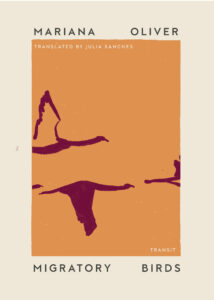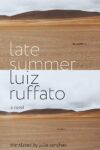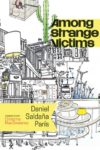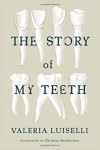
[Transit Books; 2021]
Tr. from the Spanish by Julia Sanches
Perhaps the most well-known term to emerge from the work of the French philosopher-and-psychiatrist team of Gilles Deleuze and Félix Guattari, the “line of flight” names the possibility of either change or movement as well as the moment when that change occurs. Yet the translator Brian Massumi explains that in the original French phrase ligne de fuite, fuite has nothing to do with flying, even if the association has been a hard one to shake. Instead, the concept is more closely connected to the idea of a “vanishing point,” or point de fuite, which also suggests the way that, as Massumi clarifies, “line of flight” can refer to “flowing, leaking, and disappearing into the distance.”
In the title essay of Mariana Oliver’s Migratory Birds, we encounter an observation that, in Julia Sanches’ unfailingly careful translation from the Spanish, offers another possible definition of the line of flight, even though the piece concerns something else entirely. “Sometimes, out of the blue,” Oliver writes, “you might catch a glimpse of the future. A moment of insight that disrupts the day-to-day, a revelation that becomes impossible to shake off.” The essay, one of ten in the Mexican writer’s collection recently released by Transit Books, is the only one to address the titular birds. As with Deleuze and Guattari’s concept, we might be tempted to locate the avian even when it is not there. But migration, the other half of the title, does constantly surface in Oliver’s meditative pieces, and this process of relocation recalls how the French pair used another term — deterritorialization — as an approximate synonym of the line of flight in order to describe how one leaves a territory while also extending and constituting it.
No matter what you call it, such movement characterizes Oliver’s collection, which, much like the work of Valeria Luiselli or María Sonia Cristoff, drifts across contexts but always alights on an unexpected insight. This question of perspective launches the first piece, which tracks the changing fortunes of Bill Lishman, a pioneer of ultralight flight who could never gain admittance to a pilot training program because of his color-blindness. Yet these rejections ultimately offered an opportunity for reinvention: aviation and the avian intertwined as he studied birds in order to construct his lightweight aircraft. This experience led him to raise some geese in his backyard, and after teaching them to fly south he assumed they would never return. Oliver suggests that, contrary to any essentialized expectation, “home is a route anchored in memory,” and it was one that those geese retraced. She expands on this more capacious conception of home by labeling it a “mirrored gesture,” as well as a “recording from childhood, an implanted memory.” Lishman himself understood this last point quite well, for he repeated his process with the geese with a group of nearly extinct whooping cranes that had been born in captivity.
The piece unfolds as an understated yet overwhelmingly moving reflection on migration that never feels compelled to state the obvious: the many forms of human migration that occur alongside those of the birds (although often in the opposite direction, from south to north). The urgency is underscored by remaining unacknowledged in any explicit sense. Oliver’s preferred structure — here and elsewhere — is one that opens up space by relying on short sections, making the essay as light and agile as Lishman’s aircraft.
The collection then swoops from the skies down to the subterranean as Oliver parallels the historical with the personal in a piece on Cappadocia. Lying underneath some of the cities in this Turkish region are extensive systems of caves that allowed inhabitants to elude attacks from invading forces. The first part of the essay deftly sketches out some of this history, while the second reveals Oliver’s discerning eye and ear for details. For instance, when describing an imam’s chant, she notes how “in his throat vowels appear to find their texture and feel unending; they are sound trapped in a cave.” (Roland Barthes could not have located a better way to capture what he famously labeled the “grain of the voice.”) Yet because the piece concerns what lies underground, her attention is often drawn downward, particularly as she observes how walking on the sandy surfaces of the region contrasts with the urban prevalence of pavement. “Asphalted cities have made it impossible for us to look back at our steps, and it’s easy to forget the path we took,” writes Oliver. “In Cappadocia, I saw for the first time the prints that my feet left on the ground as they vanished into the distance.” This sharp sense of history is ultimately inescapable as the piece ends with an uneasy thought: “I’m still not sure how different we are from those first invaders, who had no idea what lay beneath their feet.” The comparison between tourists and troops has certainly been made before, but Oliver’s set-up has ensured that it strikes us with considerable force. She amplifies the echoes of the past in the present, allowing us to hear them separately and never producing any confused cacophony.
Other resonances emerge in the fifth piece. “The Other Lost Boys and Girls” turns to the history of Operation Peter Pan, which brought Cuban children to the United States shortly after the revolution by suggesting that Castro would take them away from their parents. Some 14,000 unaccompanied minors were sent to the U.S. between 1960 and 1962, and many families were never reunited, which leads to one of Oliver’s most devastating declarations: “we always know more about farewells than we do about reunions.” Here, as with the piece about Lishman, it feels impossible not to consider the connections to current abhorrent practices at the border, but Oliver understands that the essay can speak for itself — that being so blunt would in fact dull its effects.
This oblique approach recalls the work of one of the children sent to the United States as part of the Peter Pan operation: Ana Mendieta. A well-known visual artist who frequently dealt with themes of exile, Mendieta often produced pieces that explored traces, imprints, vestiges. In the photographs that recorded these experiments, what takes precedence is not the presence of a body but rather the unmistakable evidence that one was there. This is very much an art of contemplating absence, and it is one that Oliver has also made her own.
Of course, Oliver works with words rather than by mixing other media, and the sixth piece, titled “Özdamar’s Tongue,” examines how we speak of migration as well as how migration occasionally speaks for us. “The tongue does not have bones,” explains the epigraph to this piece, “it twists in the direction we twist it in.” This line comes from the author alluded to in the title: Emine Sevgi Özdamar, a Turkish woman who would go on to write largely in German. In 1965, she moved from Istanbul, a city divided by the Bosporous, to Berlin, a city divided by a wall. She formed a part of a wave of migrants whose assistance was welcomed in the post-war period but whose presence was never fully recognized. They were referred to as Gastarbeiter, or guest workers, and they spoke a language of their own (at least to the ears of the Germans): gastarbeiterdeutsch, or guest worker German.
This dismissive and exclusive attitude is one that neither Özdamar nor Oliver endorses. The piece instead reflects on what it means to come into contact with other languages — as well as with other speakers of the languages we might mistakenly call “ours” — and how we would do well to welcome those encounters. “We should adopt words across languages into our everyday vernacular,” Oliver writes. “Pronounce them as confidently as we do those of our childhood, mark them with our accents, voice modulations, and necessary pauses. Speak them as though they were ours, find a context for them in which their meanings explode and envelop us. Turn our mother tongues into open spaces that can accommodate any word we choose or happen to come across at a particular time.” Such a space is not simply one of translation but also one where multilingualism is the expectation rather than the exception.
This sixth piece then closes with Oliver’s recollection of her own visit to Berlin in the company of two young Turkish women. Her memory is somewhat faded, for she fails to remember which language they spoke after having taken a German course in a small university town. “Maybe we spoke Denglisch, an improvised mix of English and German common among foreigners in transit,” she remarks. “An improvised language that exists outside grammar and has no correct accent or clear-cut spelling, a language that is there to be spoken, and for us to quickly forget what was said in it.” But the transitory nature of that language creates impressions that are anything but temporary. As Oliver explains in the final paragraph of the piece, a subsequent trip to Berlin felt like a different city, not only because it happened with other interlocutors but also because it took place in another language.
Germany also features prominently in other essays, which is hardly a surprise since Oliver had studied German literature at university. In one memorable remark from an interview, she frames her time in that country by emphasizing that “remembering and forgetting are part of the same process. What perturbed me a little, when I arrived in Germany, was seeing cities in which it seemed like the war had not happened.” She counteracts this tendency to forget in pieces like “Trümmerfrauen,” which recounts the work of the women — and they were only women, given the significant number of war widows — who carefully sifted through the rubble of the destroyed cities of Germany. Unlike other essays in the collection, this one revolves around a photograph, revealing Oliver’s skill at narrating an image into existence. (Here, too, we might think of Barthes, author of the elegiac Camera Lucida, who would no doubt approve.) Just as powerfully, a piece titled “Koblenz” underscores our inability to entirely elude the past. As Oliver reminds us, two out of every ten bombs that the Allies dropped never went off, meaning that they require evacuations whenever they do appear. These explosive devices produce a sense of unease that also materializes in a wide-ranging meditation on the meaning of Christa Wolf, a figure who embodies so many of the contradictions and conflicts in Germany that fascinate Oliver.
One of the pieces with an unanticipated relevance in 2021 is “Mimesis in VHS,” which not only deals with the titular video tape technology but also explores the Ebola outbreak of 2014. Here, Oliver combines memory with televised spectacle almost as if they were the two reels of a tape. In fact, the one does feed into the other — the cassettes that shaped her past and the CNN she consumes in the present both shape her understanding of what unfolds as patients with the disease disembark from an airplane in Atlanta only to be greeted by protesters. As a result, the essay, as Oliver practices it, becomes a form as dynamic as the black pieces of plastic with the recordings: in Oliver’s hands, the essay, like the cassette, is a container that does not dictate content but rather proves to be remarkably capacious.
Like the birds in the first piece, the final essay of the collection returns to the concept of home. “Blueprint for a house” uses the idea of an architectural plan to construct or perhaps deconstruct what counts as home, but the question of what it means to inhabit a space comes into sharper focus, particularly as Oliver observes that “the house is stitched to our bodies; it lives within us.” Such a reversal of the typical agent and action — here it is the house that lives — indicates how much home can be a process as well as a place, and the same sense of intimacy reappears with the proposal that “we should only call home spaces we can fumble through in the dark.” As with so much of the collection, this piece attests to how Oliver has made the essay form her home. Here, there is no clumsiness, only a dexterity that Sanches so adroitly conveys. This final essay also returns to translation and the question of what different languages demand. “German prepositions vary depending on the movement or stillness of the thing referred to,” explains Oliver at one point in this pedagogically-inflected yet profound essay. “A bird that flies over a bridge is not the same as a bird that perches on it.” Elsewhere, in an interview, she makes a similar point by arguing that “a person who moves cannot be the same as the one who stays still.” As the collection demonstrates time and again, such movement across territories, languages, and temporalities offers a radical possibility to reframe our perspective. What makes a bird’s-eye view — and here we might also even say a Migratory Birds-eye view — is thus not so much the altitude as the movement. For that reason, it will be worth watching where this young Mexican writer sets her sights next before she takes flight once more.
Sam Carter is a writer and editor whose work has appeared in Public Books, Real Life, Music & Literature, and elsewhere.
This post may contain affiliate links.







